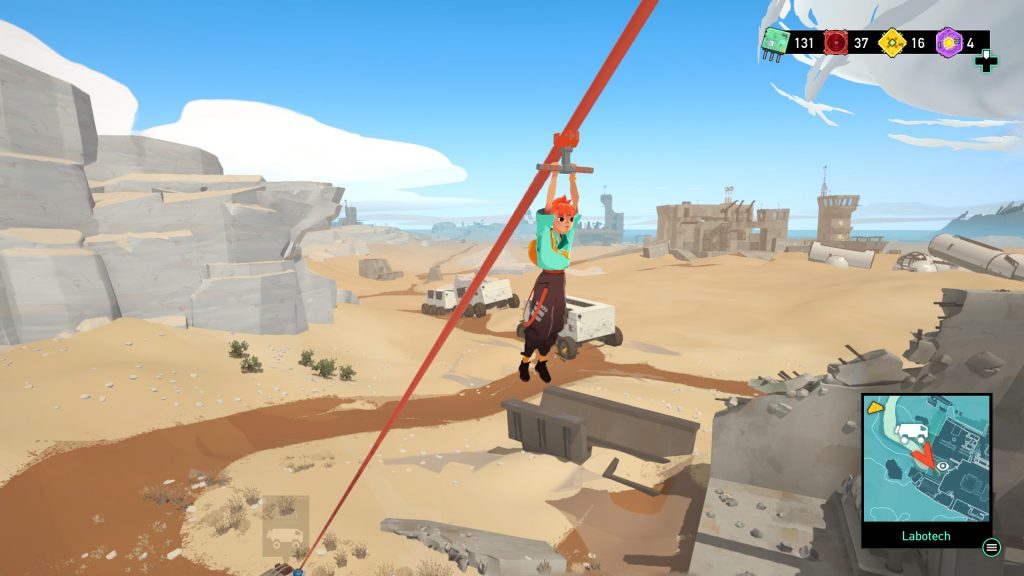Caravan SandWitch PC Review
Summary: An open-world collect-a-phon about exploring, set mostly in an open and empty desert. It's fun to explore, though the necessity of the first few van upgrades is a frequent hinderance to trying to explore the entire world right away once it opens up to you fully in chapter 2.
4
Toaster!
I’ve always thought that caravans, sand and witches belonged together in a video game. Luckily, Studio Plane Toast has my back. Caravan SandWitch is a tale of exploration. Returning home after years away from the planet and constantly watched by the titular Sand Witch, the player directs the adventurous Sauge across the mostly-abandoned sands of Cigalo in search of their missing sister, Garance.
The game gets right into the action, which is a huge plus for me. It takes a few minutes at most from starting a fresh save to roaming the world freely at your leisure. The first chapter locks down the map to only the north-east area, but from chapter 2, the map opens up fully. I’ve heard many times from people that one of the reasons they enjoy games like Skyrim as much as they do is the ability to look at something far off in the distance and go there. Caravan SandWitch is of course much smaller, which is for the better, but it does retain my main gripe with Skyrim — the map is very empty. Once you get out of the rocky lands and into the sand dunes there’s a lot of negative space, but at least you have the van, even if its turbo could be a little faster. The map isn’t as large as it looks either, it doesn’t take too long to get from corner to corner, and you can always fast travel back to the main village from the menu anyway.
Most of your initial adventure is a scavenger hunt for parts to build crucial upgrades for the caravan. Though the whole map opens up early, there’s still a lot you can’t access right away. This was my only real gripe, that I felt I was re-treading the same ground to meet the increasingly-difficult quota of components per chapter. This was made worse when either a softlock or incorrectly-marked objective prevented me from moving past chapter 7, despite several hours of re-exploring everything I could think of.
Along the way are a fair few side quests to engage in, some of which require completion in the chapter they’re given while others do not. Luckily, there’s a warning when ending a chapter if you still have any outstanding that will fail if you choose to continue. Since the bulk of the gameplay in following the story is platforming, using the van’s tools and exploration in general, these quests give you other objectives to keep an eye out for, such as finding mushrooms to help bring back cave creatures to safety, and puzzle exploration to uncover data archives for a talking photographer frog. The reward for completing these is a handful of components, so undertaking these quests won’t get you far ahead in the early-game race for resources. The main reason to engage in these above all else is the world-building they provide, showing more of the interactions between Sauge and the remaining residents of Cigalo.
The game has a stunning cel-shaded art style. There’s a lack of graphical options besides a framerate lock and quality presets. I found High and Epic to be surprisingly demanding, but the game looks just as good on Normal as well. It mostly only suffers on Low, particularly in shadow quality, but this was the only way I could squeeze 40 frames per second out of it on my Steam Deck. It’s a shame there was no photo mode or UI toggle button during my playtime, but it’ll release with a photo mode to take cleaner pictures. The game looks beautiful and absolutely deserves UI-less screenshots out in the world.
The soundtrack is very minimalist; centering largely around acoustic stringed instruments, soft synths and with dashes of voices, it rarely exceeds two musical parts at one time, letting the coat of reverb fill that space. There are around three overworld exploration tracks, which seem to start and stop at random. At least one track switches out its percussion when in the van, a subtle example of vertical composition. These tracks are very empty, with two based around loosely-timed clean electric guitar arpeggiation, and another entirely around hollow, synth swells. These are the tracks you’ll hear the most. On the other hand, Estello Village, where your friends in Cigalo reside, is soundtracked by a soft, nylon ukulele. Radios can be found at set points in the world, which play extra music, such as distorted sequenced synth loops or the game’s main theme, which oozes French synth-pop.
Final Thoughts
Until the point where I found myself tired of visiting the same points of interest, the air of feeling like an adventurous child who can travel and climb wherever they want without consequence felt incredibly refreshing in a way I didn’t know I needed. My experience was unfortunately soured by the roadblock of being unable to finish the game, but I still have a lot of love for its presentation and the interactions between its adorable characters.














